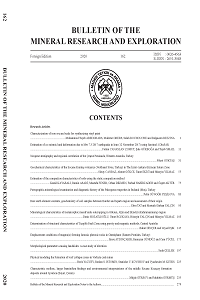Öz
Kaynakça
- American Society for Testing Materials. 2000. Standard test method for laboratory miniature vane shear test for saturated fine-grained soil. ASTM Standard D4648-00, West Conshohocken, PA.
- American Society for Testing Materials. 2003. Standard Test Methods for Laboratory Compaction Characteristics of Soil Using Standard Effort. ASTM D668-00, West Conshohocken, PA.
- Basheer, I. A. 2001. Empirical modeling of the compaction curve of cohesive soils: Canadian Geotechnical Journal 38, 29-45.
- Bell, J. R. 1977. Compaction energy relationships of cohesive soils: Transportation Research Record No. 641, Stabilization of Soils 29-34.
- Day, S. R., Daniel, D. E. 1985. Hydraulic conductivity of two prototype clay liners: ASCE Journal of Geotechnical Engineering 111(8), 957-970.
- Hadas, A.1987. Soil compaction under quasi-static and impact stress loading: Soil and Tillage Research 9, 181-186.
- Sridharan, A., Sivapullaiah, P. V. 2005. Mini compaction test apparatus for fine grained soils: Geotechnical Testing Journal 28(3), 1-7.
- Tien, Y. M., Wu, P. L., Chuang, W. S., Wu, L. H. 2004. Micromechanical model for compaction characteristics of bentonite-sand mixtures: Applied Clay Science 26, 489-498.
- Venkatarama Reddy, B., Jagadish, K. S. 1993. The static compaction of soils: Geotechnique 43(2), 337-341.
Öz
Ground improvement using mechanical stabilization is commonly applied by performing the standard Proctor compaction test, which requires a significant quantity of soil, usually obtained from open pits. A static compaction test is an alternative laboratory compaction test. Although researchers have shown that the results of miniature size static compaction tests are comparable with that of standard Proctor tests in terms of the maximum dry density and the optimum water content, no attempt has been made to compare the two fundamental properties of the compacted soil: undrained shear strength and hydraulic conductivity. The scope of this investigation was to estimate the level of static compaction energy required to (1) obtain a compaction curve similar to that of the standard Proctor test; (2) reconstruct compacted soils using the standard Proctor and static compaction tests at the optimum water content; and (3) compare the undrained shear strength and hydraulic conductivity of compacted soils. The compacted soils at the predetermined energy level were subjected to hydraulic conductivity tests using the rigid-wall falling-head permeability method. Undrained shear strength tests were performed by employing a high-capacity laboratory vane shear apparatus on compacted samples of both the standard Proctor and static compaction tests. The present investigation revealed that the static compaction test, requiring about only 10% of the soil necessary to perform the standard Proctor method, provides comparable results in regard to hydraulic conductivity and undrained shear strength.
Anahtar Kelimeler
static compaction Standard Proctor Unconfined compressive strength Permeability Compaction energy
Kaynakça
- American Society for Testing Materials. 2000. Standard test method for laboratory miniature vane shear test for saturated fine-grained soil. ASTM Standard D4648-00, West Conshohocken, PA.
- American Society for Testing Materials. 2003. Standard Test Methods for Laboratory Compaction Characteristics of Soil Using Standard Effort. ASTM D668-00, West Conshohocken, PA.
- Basheer, I. A. 2001. Empirical modeling of the compaction curve of cohesive soils: Canadian Geotechnical Journal 38, 29-45.
- Bell, J. R. 1977. Compaction energy relationships of cohesive soils: Transportation Research Record No. 641, Stabilization of Soils 29-34.
- Day, S. R., Daniel, D. E. 1985. Hydraulic conductivity of two prototype clay liners: ASCE Journal of Geotechnical Engineering 111(8), 957-970.
- Hadas, A.1987. Soil compaction under quasi-static and impact stress loading: Soil and Tillage Research 9, 181-186.
- Sridharan, A., Sivapullaiah, P. V. 2005. Mini compaction test apparatus for fine grained soils: Geotechnical Testing Journal 28(3), 1-7.
- Tien, Y. M., Wu, P. L., Chuang, W. S., Wu, L. H. 2004. Micromechanical model for compaction characteristics of bentonite-sand mixtures: Applied Clay Science 26, 489-498.
- Venkatarama Reddy, B., Jagadish, K. S. 1993. The static compaction of soils: Geotechnique 43(2), 337-341.
Ayrıntılar
| Birincil Dil | İngilizce |
|---|---|
| Konular | Mühendislik |
| Bölüm | Makaleler |
| Yazarlar | |
| Yayımlanma Tarihi | 15 Ağustos 2020 |
| Yayımlandığı Sayı | Yıl 2020 Cilt: 162 Sayı: 162 |
Kaynak Göster
Cited By
Static Compaction for Sustainable Geotechnical Solutions: A Comprehensive Study
Journal of Mines, Metals and Fuels
https://doi.org/10.18311/jmmf/2024/35529
Copyright and Licence
The Bulletin of Mineral Research and Exploration keeps the Law on Intellectual and Artistic Works No: 5846. The Bulletin of Mineral Research and Exploration publishes the articles under the terms of “Creatice Common Attribution-NonCommercial-NoDerivs (CC-BY-NC-ND 4.0)” licence which allows to others to download your works and share them with others as long as they credit you, but they can’t change them in any way or use them commercially.
For further details;
https://creativecommons.org/licenses/?lang=en


